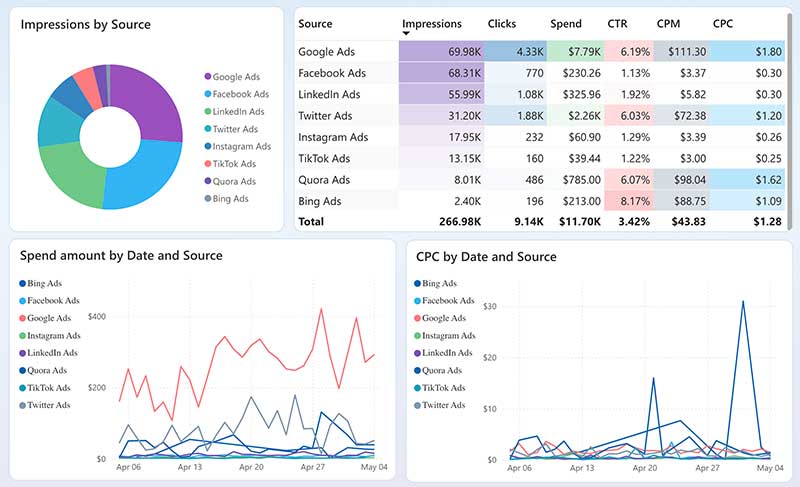Multi channel marketing is no longer a luxury. It’s the backbone of how modern businesses connect, engage, and convert across an increasingly fragmented digital landscape.
But while executing across multiple platforms can sound impressive, the real value lies in measuring it. That’s where too many strategies fall short.
In this article, we’ll break down what Measuring Success in Multi Channel Marketing really means, the metrics that matter, and how to align your tracking efforts to the channels that actually drive results.
Why Measurement Defines Multi Channel Success
If you’re running campaigns across paid search, organic SEO, LinkedIn, email, and maybe even offline events, you’re already juggling a complex web of touchpoints. But without a unified view of how each channel contributes to growth, it’s just noise.
Measuring Success in Multi Channel Marketing gives you clarity. It allows you to:
- Understand how users move across platforms before converting
- Identify what’s driving first-touch and last-touch attribution
- Spot inefficiencies and reallocate spend
- Prove ROI to stakeholders who care about outcomes, not effort
It’s not about chasing more metrics. It’s about tracking the right ones with the right intent.

Step 1: Define What Success Looks Like Before You Launch
It sounds obvious, but it’s often skipped.
Before launching any campaign, define what you want to measure and why. For some, it’s lead generation. For others, it’s brand awareness, pipeline velocity, or lifetime value.
Each of these success metrics will shift how you look at your channels.
Ask:
- Are you measuring leads, meetings booked, or closed deals?
- Is engagement the goal or is it driving form fills and revenue?
- Are you looking at top-funnel or bottom-funnel activity?
When you’re clear on your objective, Measuring Success in Multi Channel Marketing becomes a much more streamlined process.
Step 2: Build the Foundation — Attribution and Analytics
A strong measurement strategy needs the right architecture. Google Analytics 4, LinkedIn Campaign Manager, HubSpot, Salesforce, and server side tag management tools all play a part. But what ties them together is attribution.
Multi channel attribution models help answer one core question:
“Which touchpoint deserves the credit?”
Whether you’re using data driven attribution or building custom models in GA4, the goal is to track full customer journeys, not just single clicks.
Also, make sure:
- UTM parameters are applied consistently across all campaigns
- First and last interaction touchpoints are tracked
- Cross domain tracking is working properly
- Lead source data flows cleanly into your CRM
If you skip these steps, Measuring Success in Multi Channel Marketing becomes unreliable and misleading.
Step 3: Metrics That Matter — What to Track and Why
You don’t need 100 dashboards. You need one that makes sense.
Here are the core metrics I track across nearly every multi channel client engagement:
- Customer Acquisition Cost (CAC)
- Cost Per Lead (CPL) per channel
- Conversion Rate by Channel
- Lead Quality or MQL to SQL conversion rates
- Time to Conversion
- First Click vs. Last Click impact
- Incremental Lift from Cross Channel Exposure
It’s easy to get caught up in vanity metrics like impressions or clicks. But for true growth, you need to know how channels support each other and where they break down.
Step 4: Connect the Dots — From Insight to Action
The best insights are the ones that change behavior.
Once you’ve measured performance across your channels, you need to apply those insights to optimize. That might look like:
- Turning off underperforming Google Ads campaigns and reallocating that spend to high converting LinkedIn forms
- Doubling down on organic content that’s driving early stage awareness and retargeting through email
- Adjusting your offer or messaging by persona and platform
You’re not just optimizing individual channels. You’re optimizing the entire ecosystem. That’s the true meaning of Measuring Success in Multi Channel Marketing.
Step 5: Reporting with Purpose
Reporting should answer this question: “What’s working, what’s not, and what should we do next?”
I always recommend setting up a simple executive dashboard that pulls in KPIs from all sources ; GA4, CRM, paid media platforms, etc. with visual clarity on performance by channel and campaign.
Make it weekly. Make it focused. And above all, tie it to outcomes.
That’s how you build credibility with your team, your clients, or your leadership.
Start with Strategy, End with Clarity
You don’t need every tool or every platform. But you do need a plan for how you’ll track and adjust.
Measuring Success in Multi Channel Marketing isn’t just about data. It’s about creating a smarter path from insight to decision. When done right, it empowers you to double down on what works, eliminate what doesn’t, and grow with confidence.
If you want help refining your own multi channel strategy or need support building attribution and reporting frameworks that actually make sense, connect with me on LinkedIn or schedule a free consultation to get started.
Let’s turn your data into direction.
👉 Connect with me on LinkedIn
📅 Or schedule a free consultation here

